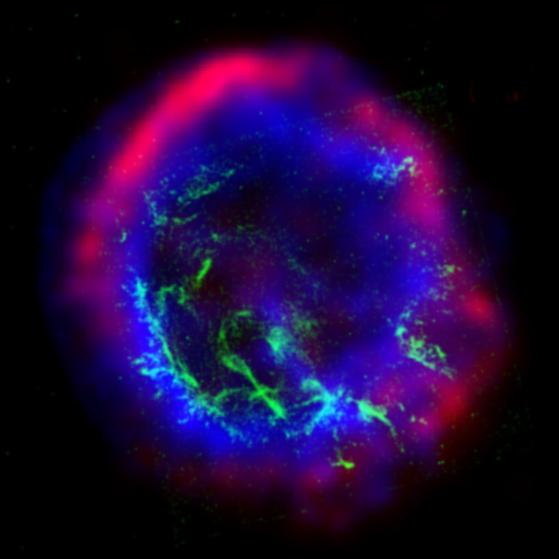
 Credit: X-ray (NASA/CXC/SAO); Optical (NASA/HST);
Radio: (CSIRO/ATNF/ATCA)
Credit: X-ray (NASA/CXC/SAO); Optical (NASA/HST);
Radio: (CSIRO/ATNF/ATCA)
A Shock Wave Coming and Going
Massive stars end their lives as tremendous explosions known as supernovae.
When the star explodes it violently throws most of the star's material into
interstellar space at enormous speeds (generally in excess of 1 million
kilometers per hour). This ejected material will collides with the
surrounding material in the galaxy (the interstellar medium), and forms a
shock wave. This shock wave consists of 2 parts - one outwardly expanding
part (the forward shock), and a reverse shock (which moves inward from the
expanding shock). The picture above, of the supernova remnant E0102-72.3,
shows what is probably the best example of this interaction. The image
shows a combination of radio (from the Australian Telescope Compact
Array), X-ray (from
the Chandra X-ray Observatory), and optical images (from the Hubble Space Telescope), in false color.
Optically, the remnant just appears to be a few disconnected green strands
of gas and dust in the sky. The radio (red) and x-ray (blue) images show
the shock in more detail as a complete spherical shell (by the way, the
exploded star was at the center of this shell but is not visible in this
image). The radio emission details the outer, forward shock, while the
X-ray image shows the extremely hot gas produced by the inward moving
reverse shock.
Last Week *
HEA Dictionary * Archive
* Search HEAPOW
* Education
Each week the HEASARC
brings you new, exciting and beautiful images from X-ray and Gamma ray
astronomy. Check back each week and be sure to check out the HEAPOW archive!
Page Author: Dr. Michael F.
Corcoran
Last modified September 8, 2000


